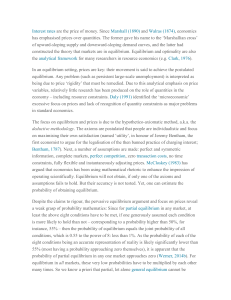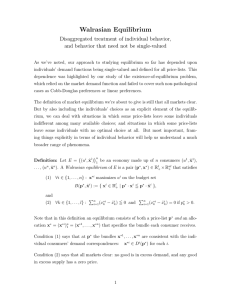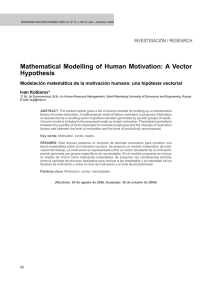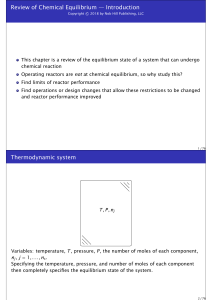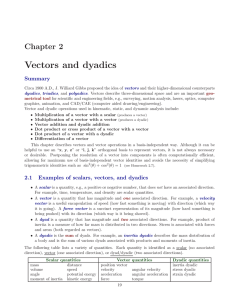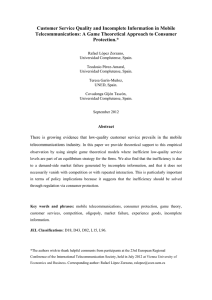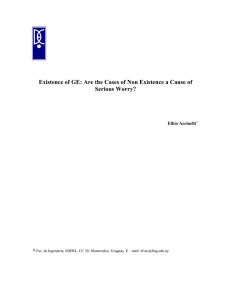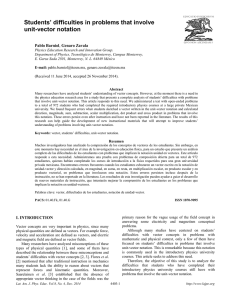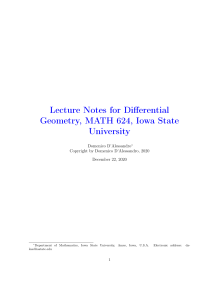The Review of Economic Studies Ltd.
Anuncio
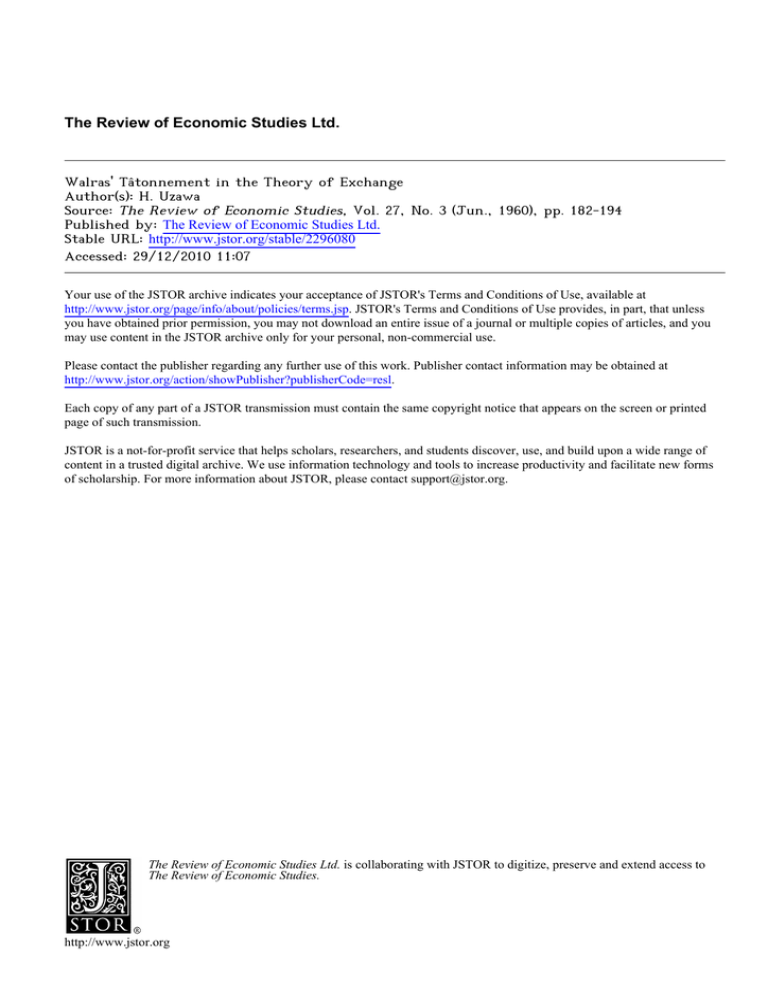
The Review of Economic Studies Ltd. Walras' Tâtonnement in the Theory of Exchange Author(s): H. Uzawa Source: The Review of Economic Studies, Vol. 27, No. 3 (Jun., 1960), pp. 182-194 Published by: The Review of Economic Studies Ltd. Stable URL: http://www.jstor.org/stable/2296080 . Accessed: 29/12/2010 11:07 Your use of the JSTOR archive indicates your acceptance of JSTOR's Terms and Conditions of Use, available at . http://www.jstor.org/page/info/about/policies/terms.jsp. JSTOR's Terms and Conditions of Use provides, in part, that unless you have obtained prior permission, you may not download an entire issue of a journal or multiple copies of articles, and you may use content in the JSTOR archive only for your personal, non-commercial use. Please contact the publisher regarding any further use of this work. Publisher contact information may be obtained at . http://www.jstor.org/action/showPublisher?publisherCode=resl. . Each copy of any part of a JSTOR transmission must contain the same copyright notice that appears on the screen or printed page of such transmission. JSTOR is a not-for-profit service that helps scholars, researchers, and students discover, use, and build upon a wide range of content in a trusted digital archive. We use information technology and tools to increase productivity and facilitate new forms of scholarship. For more information about JSTOR, please contact [email protected]. The Review of Economic Studies Ltd. is collaborating with JSTOR to digitize, preserve and extend access to The Review of Economic Studies. http://www.jstor.org Wairas' Theory Tatonnementin of the Exchangel In Walras'theory of generalequilibrium,an importantrole is playedby the concept there are of tatonnement. In spite of many contributionsto the theory of tatonnement,2 still interestingproblemswhichhave not been satisfactorilysolved. In the presentpaper, we intendto fill some of the gaps in that theory; especiallywith regardsto the stability problemof tatonnement processes. In [14],Walrasfirstconsidersan economicsystemin whichonly exchangeof commodities betweenthe individualstakes place, and then proceedsto handlemore complicated systems in which productionof commoditiesor capital goods becomes possible. In any economic system, however, he shows by counting the numbersof the economic variables(unknowns)and the relations(equations)which prescribethose variables,that it is theoreticallyor mathematically possibleto determineequilibriumvaluesof the economic variables. He then shows that the problemof determinationof equilibriumvalues of the economic variablesis enmpirically, or in the market,solved by the tdtonnement processwhichrepresentsthe mechanismof the competitivemarket. In an exchangeeconomy,the competitivemarketprocessconsistsof a price adjustment by which the price of a commoditywill rise or fall accordingto whetherthereis a positive excess demandor a positiveexcess supply of the commodity. Walrashimself, however,does not makeclearwhatis meant by his tatonnementprocess. In particular, he has two distinct tatonnementprocesses in mind: the one with simultaneous adjustment,and the other with successiveadjustment,both with respect to prices of commodities. For example,the passageson pp. 170-2, [14], in which he attemptsto prove the stabilityof the process,show that his processis one of successivepriceadjustprocess ments, while the summaryon p. 172, [14], seems to suggestthat his tatonnement is a simultaneousprice adjustment. Let us considera competitiveexchangeeconomy with n + I commoditiesand R participants. Commodities will be denoted by i = 0, 1, .. ., n, while individual participants will be denoted by r = 1, . . ., R. At the beginning of the market day, each individual has certainamounts of commodities,and duringthe marketday the exchangeof commoditiesbetweenthe individualswill take place. Let the amountof commodityi initially heldby individualr be y'i,i = 0, 1,..., n ; r = 1, . . ., R. Ugingvectornotation,we may say that the vectorof the initialholdingsof individualr is r = 1, .I . R. irY. ... j,Ynp') yr = (YOS It will be assumedthat each individualhas a definitedemandschedulewhena market price vector and his income are given. Let the demandfunctionof individualr be M) xr(p, Mr) = [X?o(Ps . . . , xn(p,Mr)], * This work was supportedby the Officeof Naval ResearchunderTask-074-4004. 1 The author is indebted to ProfessorsK. J. Arrow, R. Dorfman, L. Hurwicz, and G. Tintner for their valuablecomments and suggestions. 2 The readeris in particularreferredto an excellentnote by ProfessorPatinkinfor the most complete treatmentof the theory; [8], pp. 377-385. 182 WALRAS' TATONNEMENT IN THE THEORY OF EXCHANGE where p = 183 . ., pn) is a market (accounting) price vector and Mr an income of indi- (Po, pl. vidual r. By a price vector p is meant a non-zero vector with non-negative components. Each deinand function Xr(p, Air) is assumed to be continuous at any price vector p and income Mr, and to satisfy the budget equation n E p i=O X'r(p, = Air) Air. If a price vector p = (Po, p, . pn) has been announced to prevail in the whole market, then the income Mr (p) of iindividualr is n Mr(p) = YEpiy,, r = 1, . ,R. i=O Hence the demand function of individual r becomes xj[p, aggregate function is now defined by Mr(p)], r 1, . . ., R. The R xi (p) = x [p, Mr(p)J, i-0 E and the excess demand function z(p) zi (p) = I 1, (z0(p), X. , i . . ., zn(p)) by xi (p) -yi where R yi - i- Sy~, 0,1,...n. The excess demand function z(p) is continiuousat any price vector p, and homogeneous of order zero. It may also be noted that the Walras lawvholds n (1) X pi zi(p) 0, = for any price vector p = (po, Pi... ,pn) i=O A price vector p zi(p) < 0, i = 0, 1, ... , , pn5)is defined to be an equilibrium price vector if (Po, Pfi n, which in view of the Walras Law (1), may be written, z (fp) 0, if p3 > 0, zt( 6-< 0, ifp = 0. The main problem in the theory of exchange of commodities is now to investigate whether or not there exists an equilibrium, and if such exists, how one can determine an equilibrium. In what follows, we will rigorously show that the problem is solved by the Walras' tatonnenment process.' 1 The existence of an equilibriumfor the Walrasian modcl of general equilibriumwas rigorously proved by, e.g., Wald [13] and Arrow and Debreu [2]. The competitiveeconomy of exchangewith which we are concernedin the presentpaper is a specialcase of the Arrow-Debreumodel hence, their existence proof can be applied. We are, however, interested in applying the Walrasiantztonnement process in order to give a proof of the existenceof an equilibrium,which will be done in the Appendix. 184 REVIEW OF ECONOMIC STUDIES Let us interpret the competitive exchange economy as a game which R individuals and a fictitious player, say a Secretary of Market, play according to the following rules: (i) Secretary of Market announces a price vector. (ii) Each individual submits to Secretary of Market a " ticket" on which the quantities of demand and supply made by the individual according to the announced price vector are described. (iii) Secretary of Market calculates the quantities of aggregate excess demands from the tickets submitted to him by the individuals. (iv) Secretaryof Market announces a new price vector such that prices of commodities which have a positive excess demand will rise, and prices of commodities which have a negative excess demand (a positive excess supply) will fall. Moves (ii) and (iii) are repeated at the new price system. The game is continued until Secretary of Market announces an equilibrium price vector. Let p(t) = (po(t), . . , p4l(t)) be the price vector announced by Secretary of Market at the t-th stage, t = 0, 1, 2, ... ., ad inf. Then the rule (iv) may be mathematically formulated as follows :1 . (2) pj(t + 1) = max {0, pi(t) + fi(t)}, t = 0, 1, 2, . i = 0, 1, ... n., where fi(t) has the same sign as z[p(t)]. The tdtonnementprocess (2) leaves the price vector p(t) invariant if and only if it is an equilibrium price vector.2 The process (2), as will be shown in the Appendix, enables us to prove the existence of an equilibrium price vector pi = (Po0,j31 . . . fin). Now we take as a nume'rairea commodity, say commodity 0, which has a positive price at an equilibrium, and suppose that prices are expressed in terms of the nume'raire good, i.e., we consider only those price vectors p = (po, Pi, ... pn) for which , Po 1. In what follows, by a price vector p is meant an n-vector (P, components. .... , pn) with non-negative The simultaneous tatonnementprocess (2) accordingly may be reformulated by (3) pi(t + 1) = max { 0, pi(t) + fi(t) }, t = i = ,1, 2, ...; 1, ... ,n. We now investigate the stability problem3, i.e., whether or not the price vector p(t) determined by the tatonnementprocess (3) converges to an equilibrium price vector. 1 It may be noted that the system of (2)' Jh = max {O, pi + fi(p)} -p, differentialequationscorrespondingto (2) is given by i = O, 1, . . ., n. The process of price adjustmentrepresentedby (2)', is a special case of the ones discussedin Arrow, and Hurwicz[1], p. 94. The solution to the process(2)', however,remainspositivewheneverthe initialposition is positive. 2 See Walras[14], p. 172. 3 For recent contributions to the stability problem, see, e.g., Arrow and Hurwicz [3] and Arrow, Block, and Hurwicz[1]. WALRAS' TATONNEMENT IN THE THEORY OF EXCHANGE 185 It is noted that the Lyapunov stability theorem' may be modified so as to be appropriately applied to our tdtonnementprocess ; namely we have the following: Let p(t; p°) be the solution to the process (3) with initial price THEOREM.2 STABILITY vectorpO.If (a) the solution p(t; pO)is boundedfor any initial price vector p0; and (b) there exists a continuousfunction @((p)defined for all price vectors p such that p(t) = ( [p(t; p0)] is strictly decreasing unless p(t; pO)is an equilibrium; then the process is quasi-stable. Here the process (3) is called quasi-stable if, for any initial price vector p0, every limiting-point of the solution p(t; pO)is an equilibrium. In the case in which the set of all equilibria is finite, the quasi-stability of the process (3) implies the global stability. The function ()(p) satisfying the condition (b) will be referred to as a Lyapunovfunction with respect to the process (3). Let us consider the case in which the excess demand function z(p) = [z0(p), z1(p), . . , z,(p)] satisfies the weak axiom of revealedpreference3at equilibrium: (4) zo(p) + ; pizi (p) > 0, 1=1 for any equilibrium p and any nonequilibrium p. Then the simultaneoustdtonnementprocess (3) is globally stable, providedthe equilibrium vector p is uniquely determined; fi(t) = Pi[zi(p(t) ) ], P > 0 sufficiently small, i = 1, ..., n; and zi(p) are continuously twice differentiablewith a nonsingularmatrix [n a2z' io api pj aPk at the equilibriump. ,k In fact, as will be rigorously shown in the Appendix, the weak axiom of revealed preference implies that the function n (5) O(p) = i i=1 (p--pf)2 is a Lyapounov function; and the Stability Theorem above may be applied. The weak axiom of revealed preference at equilibrium is satisfied if, e.g., all the commodities are strongly gross substitutes4 or there is a community utility function. 1 We are concerned with the so called Lyapunov second method. See Lyapunov [6] or Malkin [7]. The first application of the Lyapunov second method to the economic analysis was done by Clower and Bushaw [4]. 2 The present Stability Theorem is a difference equation analogue of the one which was proved in Uzawa [12] for systems of differential equations. For the proof, see the Appendix. 3 The weak axiom of revealed preference which was originally introduced by Samuelson [9] and Wald [13] is usually formulated as follows: (4)' For any two price vectorspi and p2, pI z(pl) 2 pl z(p2), z(pl) : z(p2) imply p2 z(pl) > p2 z(p2). It is easily seen that (4)' implies (4). 4 See Arrow, Block, and Hurwicz [1], Lemma 5, p. 90. 186 REVIEW OF ECONOMIC STUDIES We shall next be concerned with the successive tdtonnement process which was introduced by Walras in [14], pp. 170-2. The process under consideration consists of a price adjustment which successively clears the markets of commodities. Let p(0) = [pi(0), . . . , pn(O)]be a price vector initially announced. Secretary of Market first pays attention to the market of commodity 1, and determines the price pl(l) of commodity 1 at the next stage so that there will be no excess demand at price vector [p(l)), (0), * * *n(0)]. Z[IP1, P2(0), ..., In other words, he solves the equation = 0, p(0)] with respect topi. He then goes on to consider the market of commodity 2 and determines the price p2(l) of commodity 2 by solving the equation z2[p(1), P2, p3(0),..., p (0)] -= 0, with respect to P2. The prices P3 (1), . . . , pn(l) are determined successively. In general, the price pj (t + 1) of commodity j at stage t + 1 is determined so as to satisfy the equation zj [pi(t + 1), . . ., Pji-i (t + 1), pj(t + 1), pj+,(t), ..., pn(t))] = O, t = 0, 1,2,.. ;j = 1,...,n. In taking into consideration the requirement that prices should be non-negative, we may modify the above process as follows: pj(t + 1) is determinedso as to satisfy the relation that' (6) z[p(t . . ., pl(t + 1),1), pj(t ),. . . , p(t)] r= 0, if pj(t + 1) > 0, 0, if pj(t + 1) = 0, [ t = 0, 1,2,.. ;j = 1, .. .,n. In order for the successive tdtonnementprocess to be possible, it is required that, for any non-negative p(t + 1), . . ., pj_(t + 1), p+(t), . . ., pn(t), the relation (6) should have a unique non-negative solution pjtt + 1). It is evident that a price vector p(t) = [pl(t), .. . , pn(t)] is left unchanged by the successive tdtonnementprocess if and only if p(t) is an equilibrium price vector. We shall now consider the stability of the process defined by (6). Theorem remains valid for the successive tdtonnementprocess (6). The Stability Let us first consider the case in which all commodities are strongly gross substitutes; i.e., for any commodityj, including the numeraire,the excess demand function zj (pi ... , pn) is a strictly increasing continuous function of prices of commodities other than j. In this ) is uniquely determined and is positive. case, the equilibrium price vector P = ( ., . . . We have the following theorem: If all commodities are strongly gross substitutes, the successive tdtonnementprocess (6) is globally stable. 1 The system of differenceequations(6) definesan iterativemethod for solving systems of equations which is known as the Gauss-Seidelmethod in numericalanalysis. The case handled by Seidel [11] is the one in which z(p) is linear, [azi/apj]i,j is symmetrical,and azi/?ppare all positive. Another formulation of the successivetdtonnementprocess was discussedby Professor M. Morishimain an unpublished paper. WALRAS' TATONNEMENT IN THE THEORY OF EXCHANGE 187 For the case : n = 2, the global stability of the process (6) may be easily seen from the Figure. The general case will be proved in the Appendix. p2 zt(p).O z2(P)o 'Pi PI We next consider the stability of the process (15) for the case in which the following two conditions are satisfied : (7) For any fixed p Z(pi, . . ., p-1, pj, . . ., P+i ,. j-, ., Pn, the equation p+1, . ., S,) == 0 has at most one non-negative solution with respect to pj, and Zj(pi .,* IP-i+- PP . . . Pn) < 0, for sufficiently large p;. (8) There is a differentiable function (I(p) defined for all positive price vectors p such (p), that, for some positive functions X(p), . . ., -= Xj(p)Zj(p), j = 1, . . ., n. The condition (8) is satisfied if, e.g., there is a community utility function or the excess demand function has a symmetric matrix of partial derivatives. In this case, the successive tdtonnementprocess (6) is quasi-stable. The function N(p) satisfying the condition (8) becomes, as will be shown in the Appendix, a Lyapunov function for the process (6). We thirdly consider the two-commoditycase in which the condition (7) is satisfied. The successive tdtonnementprocess (6) then is trivially stable. In fact, the relation (6) for t = 0 is reduced to z[pi(l)] = 0, which, by the Walras law, implies that pl(l) is an equilibrium price of commodity 1. 188 REVIEWOF ECONOMICSTUDIES It maybe finallynotedthatthe abovethreecases,togetherwiththe dominantdiagonal case, exhaustthe cases essentiallyfor which the stabilityof the Samuelsonprocessa differentialequationformulationof the successivetdtonnement process-is known." H. UZAWA. Stanford. See Samuelson(101,partII; ArrowandHurwicz[31; Arrow,Block,andHurwicz[1]. APPENDIX 1. Proof of the ExistenceTheorem We firstnormalizepricevectorssuchthat the sum of pricesof all commoditiesis one. Let P be the set of all pricevectorsthus normalized: P ={p = (Po,P1, . .,pt): pt2i= 0,i=0 1, . . ., n, and E pt = 1} I-0 Thesimultaneoustttonnement process,inducedon the setP of normalizedpricevectors, T(p) = (TO(p)). .., Tn(p) defines the following mappingp (9) m()max {O,p' + f zi(p)}, i=0,1,...,l T,(p) = n, p gP, whereA is a positivenumberand n X(p) = lio max{0, pt + zi(P)} It is evidentthat ) (p) > 0, and T(p) is a continuousmappingfrom P into itself. Hence, by applyingthe Brouwer fixed-pointtheorem,'we knowthat thereexistsa normalizedpricevector = p(p .... fin) suchthat p-=T(A). which,in view of (9), may be written i = 0, 1, ...,n. i = max {0jp + , ztO ) Multiplying(10)bypi andsummingover i = 0, 1,.. , n, we get (10) X n I )n 1f0 1-0 f-0 which,by the Walraslaw, implies Hence,p is an equilibriumpricevector. 1 Cf., e.g., Lefschetz[5], p. 117. Q.E.D. WALRAS' TNTONNEMENT IN THE THEORY OF EXCHANGE 189 2. Proof of the Stability Theorem Let p(t) be the solution to the process(3) with an initial price vectorp(O)which is arbitrarilygiven, and let p* be any limit-pointof p(t), as t tends to infinity; i.e. p* = lim p(tV), V --00 Considerthe solutionp*(t) to the process(3) with initial for some subsequence{ tv }. price vectorp* and definethe functionqp*(t)by p*(t) = 4D[p*(t)]. is nonincreasingand {p(t)}is bounded, lim cp(t)exists, and is Since9p(t)= OD[p(t)] t oo equal to, say, p*· =* = lim 9(t). t --* On the other hand, since the solutionp[t; p(O)]to the system(3) is continuousand unique with respectto initial position p(O),we have p*(t) = p(t;p*) = lim p[t;p(t;) V -+ = 00 lim p[t + tv; p(O)]. V --00 Hence,we have 9 *(t) = D(p*(t)) = lim D(p(t+tv)) = lim cp(t+tv) 00 v---). V--* = *, for all t, 00 which,by the condition(b), showsthatp* = p*(0) is an equilibrium. 3. Q.E.D. Stability of the Simultaneous TdtonnementProcess: The Weak Axiom Case We may without loss of generality assume that fi(t) is a sufficiently small positive number. f - fzi (p(t)), i = 1,..., n, and For the solution p(t) =p[t; p(O)] to the system(3) with an arbitrarilygiven initial price vectorp(O),we considerthe functionqp(t)definedby 9(t) = (D[p(t)], t = 0, 1, 2. We firstshow that (11) 9(t + 1) g 9(t) - f3 {2[zo(t)+± where z(t) = zip(t)]. From the relation(3), we have pfizi(t)] - z2(t) REVIEW OF ECONOMIC STUDIES 190 (12) p](t + 1) < [pi(t) + 3Zi(t)]2 = p2(t) + 2 p{(t) zt(t) + i = 1, . . ., n. P2 z(t), Summing (12) over i = 1,.. ., n, we get pp2(t+ 1) (13) i=1 i-l ; p2(t) + 2p i=l pi(t) z,(t) + 12 1= z?(t). Substituting the Wahllaslaw (1) into (13), we have (14) Z p2(t + 1) < 1=1 2 p2(t) /=1 2 2p zo(t) + z2(t). i=1 On the other hand, multiplying (3) by pi and slummingover i = 1, . ., n, we get (15) S pipi(t + 1) 2 ~ fipi(t) + P3~ pt zi(t). /=1 /=1 /-=1 n Subtractingtwo times (15) from (14) and adding Z p2, we can derive the inequality (11). i=1 Let S be the set of the commodities such that, at equilibrium jp, they have negative excess demand : S = {i: zi(p) < 0}. Equilibrium prices of the commodities in S are zero: (16) pi = 0, for i S. We shall now show that, if p is a sufficiently small positive number, there exists to such that pi(t) = 0, for all t 2 to, i e S. Let e be a positive number such that - c < 0, Zi(p) for all i e S and any price vector p such that ()(p) _ e, where c is a positive number. Since the excess demand function z(p) is continuous, it is possible to choose a positive number e which satisfies (17). We may assume without loss of generality that (17) c?(0) = 0[p(0)]. e< Let p be any positive number smaller than the following two numbers: (18) inf e / (/22 (p) 2[zo(p) + e/2 infL : pi z(p)] ()] The weak axiom (4) and the continuity of the excess demand function z(p) now imply that the two numbers defined by (18) are positive, so that the choice of p is possible. Then, by the inequality (11), we have (19) qp(t+ 1) _ ?(t) + 2 e,' if ?p(t) ! 2' WALRAS' TATONNEMENT IN THE THEORY OF EXCHANGE 191 and (t), ifj 2< p(t + 1) < (20) ?(0), 9(t) t = 0, 1, 2 . . . The inequalities (19) and (20) imply that there exists t, such that 9(t) ! (21) e, for any t 2 tl. Otherwise, p(t) is strictly decreasing and the solution p(t) is bounded, while no limit-point of p(t) is the equilibrium, thus contradicting the Stability Theorem. The relation (3) together with (17) and (21) implies that there exists to for which (16) is satisfied. The relation (16) and an argument similar to the one by which we derived (11) lead to the following : p(t + 1) (22) 9p(t) 13 {2[zo(t) + Z pizi(t)] -P ii=1 i- S z2(t) . J We shall now show that inf (23) [zo(p) + Z PiZi(p)] 0 < AD(p)_ C Z z2(p) ifs is positive. Expanding the numerator and the denominator of (23) in the Taylor series at the equilibrium p, and noting the Walras law (1), we get zo(p) + S z(p) ioS 1=1 pfizi(p) = S ajk(pj - fj) (pk - k) + 0[0(p)], j,k==l = Z bjk(pj j,k=l P) (pk - pk) + 0[D(p)],, where ajk (= - ibjk a2Zo p n - 1 aPb aPkaPZ ( (P' a2 i Azp a ) aPk k j, 1, . . .n, and 0[(D(p)]correspond to terms such that lim O[OD(p)] = O l0im) 0 0(p) The weak axiom together with the non-singularity of (ajk)j, k = , . . . , n implies, i, . . . , n is positive definite. Hence however,that the matrix (ajk)j, k REVIEW OF ECONOMIC STUDIES 192 n Zo(p) fP + zi(p) > 0. lrni= (D P) YSz (p) iqoS 0 which implies that the number (23) is positive. Now let 3 be any positive number smaller than the numbeis defined by (18) and (23). Then, by the relation (22), we have that y(t + 1) < y(t), wheneverp(t) is not an equilibrium. Applying the Stability Theorem, we have the stability of the process (3). Q.E.D. 4. Stability of the Successive TdtonnementProcess: The Gross Substitute Case Consider the functions A(p) and X(p) defined by (24) (25) A A(p) maxi (P) min 1, ' -- **s L PI) Pi''Pn {19 We shall show that, for any solution p(t) to the process (6), (26) A[p(t + 1)] ; A[p(t)], with strict inequality unless A[p(t)] = 1, and (27) ?[p(t + 1)] 2 4[(t)], with strict inequality unless 4[p(t)]J 1. Since the relation (27) is proved similarly to (26), we shall give a proof for (26). In order to prove (26), it suffices to prove the following: (28) A[p1(t + 1), . . . , pl(t + 1), p;+1(t). * 1 pn(t)] with strict inequality unless A[pl(t + 1), . . . , p;_.(t + 1), p;(t), t-=0,1,2;j= . pM(t)] ., 1, 1,...,n. Gross substitutability, homogeneity of order zero, and the Walras law (1) imply that' z;[p1(t + 1), . . . , pj-.(t + 1), p1, p;+l(t), * . *, pI(t)J] (29) whenever Pi > A[pl(t + 1), . . . , pj.1(t + 1),pj(t), 1 See Arrow,Block, and Hurwicz[1], Lemma3, p. 89. ... pn(t)]. 0, WALRAS' TATONNEMENT IN THE THEORY OF EXCHANGE 193 and, if A[pl(t + 1), . . . , p1_(t + 1), pj(t), . . . , pn(t)] > 1, (29) holds with strict inequality. But, by gross substitutability and the Walras Law|(l), zj[p1(t + 1), ... , Pj(t + l), pj pj+1(t),... , p(t)] is strictly decreasing with respect to pj. Hence, (29) implies that (30) p t A[pl(t + 1),. . ., p (t), . . . pn(t)], (t + 1), with strict inequality if A[pl(t + 1), . . ., p-(t + 1), pJ(t), . . ., pn(t)] > 1. The inequality (28) is easily implied by (30). The relations (26) and (27) in particular show that the solution p(t) to the process (6) is in a bounded set {P (Pi,. .. n) : (0) g A(0), j 1 . . ., n of positive price vectors. Since A(p) = X(p) = 1 if and only if p is an equilibrium, the relations (26) and (27) show that the function D(p) defined by 0(p) = A(p)X(p), is a Lyapanov function for the process (6). Q.E.D. 5. Stability of the Successive TdtonnementProcess; The Quasi-IntegrableCase Let D(p) be the function satisfying (8) andy j(pj) be the function defined by (31) Vi(PJ) = ¢I[p1(t+ 1), . . . , pgj-(t + 1),pj, pj+l(t), . . . p,(t)]. The defining relation (6), together with (8), shows that pj(t + 1) is a solution to the equation = 0, if p > 0, (32) (32) s(pi)\ 2 0, if pj = 0. The relations (7) and (32) show that pj(t + 1) uniquely minimizes uNj(pj)subject to pj _ 0. Hence, in particular, we have (t)], vj[pj(t + 1)] < with strict inequality if pj(t + 1) = pj(t). (33) By (31), we may rewrite (33) as follows: $[pl(t + 1), . . ., pj(t + 1), pj+1(t), . . . , n(t)] · [pl(t- + 1), . . ., p-(t + 1), pj(t), . . . pn(t)], with strict inequality if pj(t + 1) = pj(t). (34) By summing (34) over j = 1, . ., n, we get D[p(t+ 1)] 1 D[p(t)], with strict inequality if p(t + 1) = p(t). 194 REVIEWOF ECONOMICSTUDIES Hence, the function (D(p)is a Lyapounov function; and applying the Stability Theorem,we know that the process(6) is quasi-stablein the presentcase. REFERENCES [1] Arrow, K. J., H. D. Block, and L. Hurwicz, " On the stability of the competitive equilibrium : II," Econometrica 27 (1959), 82-109. [2] Arrow, K. J., and G. Debreu, " Existence of an Equilibrium for a competitive economy," Econometrica22 (1954), 256-290. [3] Arrow, K. J., and L. Hurwicz, " On the stability of the competitive equilibrium: I," Econometrica 26 (1958), 522-522. [4] Clower, R. W. and D. W. Bushaw, " Price determination in a stock-flow economy," Econometrica22 (1954), 328-343. [5] Lefschetz, S., Introduction to Topology. Princeton : Princeton University Press, 1949. [6] Lyapunov, A. "Probleme general de la stabilite du mouvement," Annales de la Faculte des Sciences de l'Universitg de Toulouse, (2), 9 (1907), 203-469. [7] Malkin, I. " On the stability of motion in the sense of Lyapunov," Recueil Math6matique [Math. Sbornik], N. S., 3 (45) (1938), 47-100. Translation: American Mathematical Society Translation No. 41 (1951). [8] Patinkin, D., Money, Interest, and Prices. Evanston: Row, Peterson and Co., 1956. [9] Samuelson, P. A., " A note on the pure theory of consumers' behaviour," Economica, Vol. 18 (1938), 61-71, and 353-354. [10] Samuelson, P. A., Foundations of Economic Analysis. Cambridge: Harvard University Press, 1947. [11] Seidel, P. L., " tber ei Verfahren die Gleichungen, auf welche die Methoden der kleinsten Quadrate fiihrt sowie lineare Gleichungen uberhaupt durch sukzessive Annahrung aufzulosen," Abhandlungender bayerschenAkademieder Wissenschaften, Math-pysik. Klasse, 11 (1874), 81-108. [12] Uzawa, H., "On the stability of dynamic processes," Econometrica, to be published. [13] Wald, A., "Uber die Produktionsgleichungen der okonomischen Wertlehre," Ergebnisse eines mathematischen Kolloquiums, No. 7 (1934-5), 1-6. [14] Walras, L., Elkments d'Economie Politique Pure, Paris et Lausanne, 1926: translated by W. Jaff6, Elements of Pure Economics, Homewood: Richard D. Irwin, Inc., 1954.
